Results
Conclusion
Our last drywall penetration test illustrated some room for improvement in the test methodologies. On the logistical side of things, our targets got cluttered with holes, making it hard to figure out what the photos were showing. What isn't visible in the photos is the immense pain in the butt required to set up and replace the targets. That could be improved, but it's not as important as the test parameters themselves: The drywall used was 5/8 inch thick instead of the half inch more often found in interior walls, so there was a possibility that the results were excessively optimistic.
Finally, with the overpenetration of handgun rounds and buckshot established, we wanted to focus on rifle rounds and include some new contenders, like 5.7x28mm and .308.
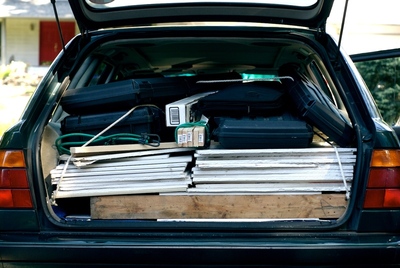
This is what scaling it back looks like.
Worst-Case Scenario
The goal of drywall testing is to simulate a worst-case scenario; i.e. a situation likely to maximize penetration. When making firearms safety decisions, it behooves one to assume the worst: The gun is loaded, the safety doesn't work, the bullet won't hit a stud or pipe, etc. You can always get lucky and have bullets penetrate less, but why even own a gun if you're going to assume that good luck will always save you?
In the case of drywall, here is what makes up a worst-case scenario:
- A straight shot into the wall. Shooting through things at an angle makes the projectile pass through more material; that's why tank armor is angled on the front of the turret. Shooting perpendicular to the surface of the wall minimizes the drywall's ability to slow the bullet.
- Empty space inside the wall. Hitting fiberglass, pipes, wiring, or studs will slow down a bullet more than empty space, but many interior walls contain no insulation and pipes, and a bullet is not guaranteed to hit wires or studs. Our test walls contained nothing but air between the two sheets of drywall.
- Walls close together. Air resistance plays a huge part in how projectiles penetrate walls, especially if the bullet deforms while passing through drywall. Realism demands that the walls be spaced far enough apart to let air drag play a role, but close enough to represent very small rooms or wide hallways. We ended up shooting the first wall from five feet away, with ten feet of space between the second and third walls. (This is the same spacing as in the previous test.)
Realism
Although we wanted a worst-case scenario, making the setup unrealistically tilted in favor of penetration wouldn't produce useful results. Here's how we tried to introduce realism:
- Stud spacing and fastening. In case the rigidity of drywall plays a part in how much it slows down a bullet, the wall sections we built used the same 2x4s as are used in wall studs and spaced them the standard 16 inches center-to-center. The drywall was fastened to the studs via drywall screws.
- Thinner drywall. For this test, we used 1/2 inch drywall instead of the 5/8 inch used in the last test. Many building codes require 5/8 inch drywall internally, but 5/8 inch may only be required in certain areas, or the building might be old or just not up to code.
- Wall spacing. As mentioned above, we spaced out the drywall sections to let air drag play a role both inside the wall and between walls. The distance was 5 feet to the first wall and 10 feet between walls.
Arms and Ammunition
Most of the ammo used is a repeat of the prior test's selection, so refer to the previous test's ammo writeup for details. That being said, we did introduce some new ammunition this time around.
The first new addition was an AR57 in 5.7x28mm. Most commonly used in the FN P90, this is a relatively high-velocity round (about 2300 FPS) with a light bullet (23-31 grains). We looked at two loadings for this cartridge.
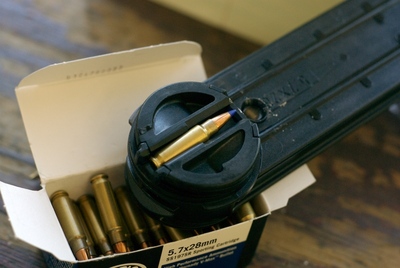
SS197 ballistic tip
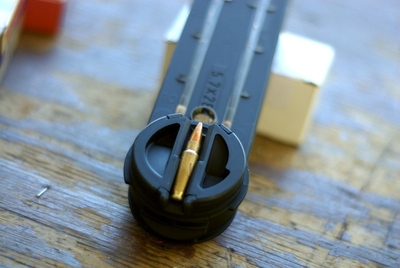
SS195 JHP
These rounds were fired from an AR57 rifle with a 16" barrel.
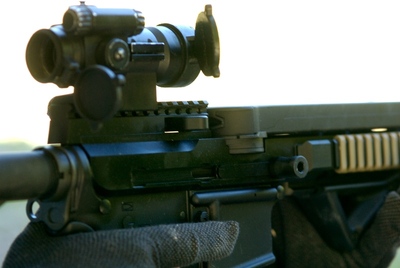
Part of the rifle in question.
We also used an AR57 pistol with a 10" barrel, which is just slightly less than the barrel length of a P90. In both cases, the drywall results were the same. I just wanted to show a picture of the pistol because it looks cool.
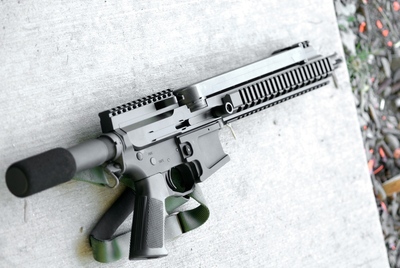
AR57 pistol
We were also curious with what would happen if you put a ballistic tip on top of 168 grains of .308 fury, so we acquired some Hornady TAP ammo and put it through a Mega Machine Shop MA-TEN with a 16 inch barrel.
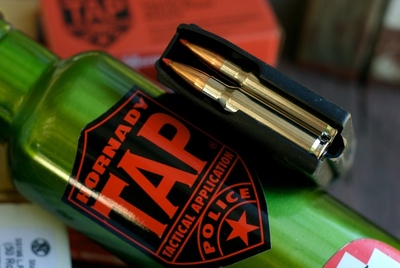
The water bottle didn't make it through the first wall.

Looks mean even from this end.
All Photos © 2012 B. Toombs
email: hidi.projects at gmail.com